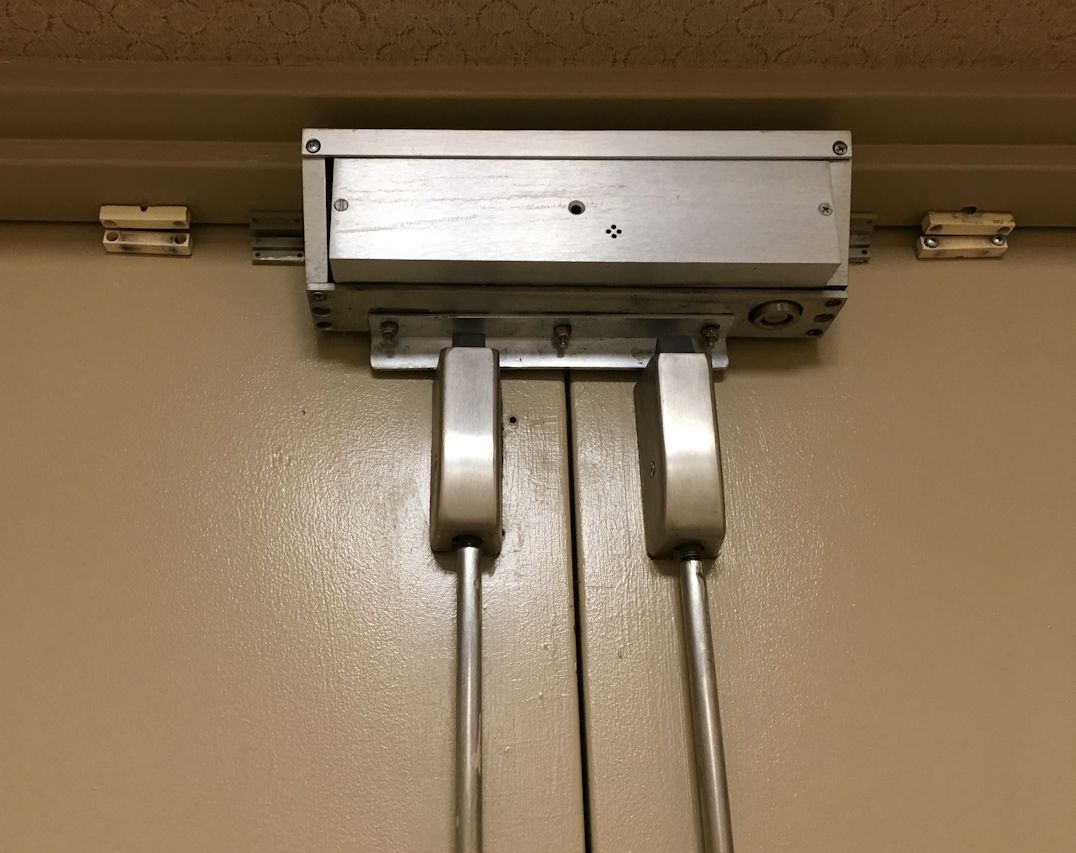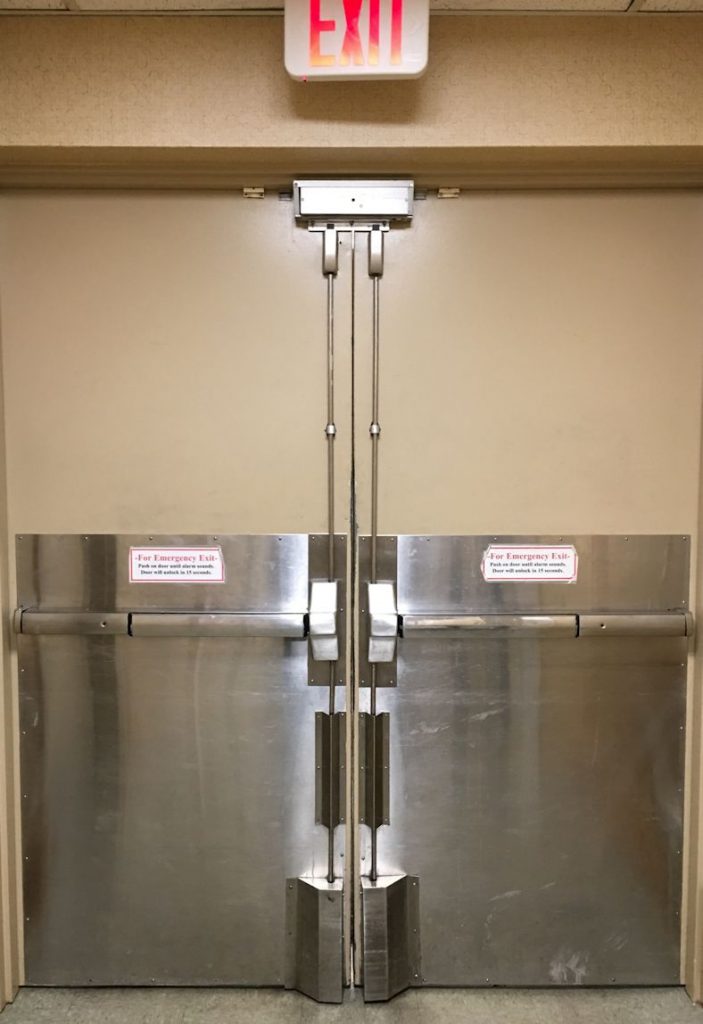With the recent adoption of NFPA 101-2012 by CMS, the annual inspection of fire door assemblies has become a top priority for many health care facilities. This has resulted in new opportunities for fire door inspectors, and the discovery of some fire door assemblies that have been modified in ways that are not code-compliant.
Susan Flowers, DAHC/CDC, FDHI, FDAI, with Cleveland-Vicon, sent me these Wordless Wednesday photos of a pair of fire doors found during a recent inspection. Who knows what the issues are? How would you bring the opening back into compliance?
You need to login or register to bookmark/favorite this content.








Wondering how the thing works??
Looks like if you pushed the panic bar, the doors would open immediately ??
Not sure what the mag lock does or is there a delay??
Answer will be interesting
Hi Charles –
The way it works is that the delayed egress mag-lock at the top of the doors holds the doors closed/locked for 15 seconds after someone presses on the panic hardware. After 15 seconds the lock releases and you can exit. The application is not the problem, it’s the way they’ve installed it on a fire door.
– Lori
For one it looks like the exit devices may have dogging. No good.
Hi Brandon –
I’m not positive, but I think the devices in the photo have the dogging hole but have a black plastic plug in the hole when it is fire exit hardware. It definitely makes it harder to tell whether it’s fire exit hardware or panic hardware.
– Lori
1. Strike not rated (Worse, its aluminum…)
2. Devices have allen hole for dogging, likely not fire rated panics
3. Application of strike to mag lock probably isn’t tested in rated application.
4. I don’t see a fire stamp on the armor plates, not that that is really an issue.
I don’t think that signage is compliant either.
Hummm
The mag looks like all one unit?
Like nothing moves, except the door
Wish there was an open door picture
Hi Charles –
When the door moves, it triggers the 15-second timer and after 15 seconds the doors can be opened.
– Lori
OK, I’m a little new to the fire door world, but wouldn’t “holding the doors closed/locked for 15 seconds…” kind of defeat the purpose of installing a fire rated door? That’s obvious even to me! 🙂
Hi Lenny –
Delayed egress is allowed in most occupancy types, and is a compromise which provides security (prevents people from leaving) while still providing an acceptable level of life safety. During a fire alarm or power failure, there is no delay – you can exit immediately. The fire rating serves a different purpose – it helps to compartmentalize the building to prevent the fire from spreading.
– Lori
Asking the question. Can a single mag-lock work? If allowed by code, would each leaf have its own mag-lock?
Hi Marco –
The code doesn’t say whether you need 1 mag-lock or 2, but I’m pretty sure 2 would be recommended for a pair of doors. With a regular mag-lock you could do a split armature but I’ve never seen that option for a delayed egress mag. I’m sure someone will correct me if I’m wrong. 🙂
– Lori
Strikes are not UL listed, armor plates are not approved for use on fire door, signage is non-compliant, bottom latch guards do not comply with accessibility requirements for bottom 10″ of door.
Best way to make compliant is to start over on the doors and locking systems. I would recommend CX CVC devices unless auto operation is required, then QEL CVC devices with (2) mag locks and wall-mounted DE5300 controller.
FYI.
A magnet loses its magnetic strength at 400 degrees.
Or when the power goes out.
– Lori
It’s ugly.
Need more pics to see if the doors even have a fire label attached. If by some chance they do, flip the janitor a $20 to make the labels disappear, and start over. That opening is absolutely hideous.
These are fire doors – they do have labels.
– Lori
Bottom 10″ of doors are not flush / smooth
My understanding is that surface vertical rod exit devices in a delayed egress application can only be installed less bottom rod, or with a rod and latch guard covering the entirety of the bottom rod and latch. Since this is a fire rated opening the latch and rod guard would need to be tested, such as the Von Duprin RG-27. The guard pictured doesn’t cover the entirety of the bottom rod, and looks to me to be something that was fabricated, not a tested product.
That is correct. Technically, a latch guard doesn’t comply with the requirement for a flush area in the bottom 10 inches of the door height, but some AHJs may allow it.
– Lori
Push on the door all days and nobody is going anywhere.
“Push on the exit device” might help.
You’re right – with this set-up you would have to push on the panic to unlatch it, then move the door a bit to trigger the mag-lock timer.
– Lori
Don’t forget the bottom of the doors issues = hint (ADA)
Very interesting way to do it. But does not Yale make a delayed egress option for these exit devices? I am assuming this is not rated hardware (giving the possibility of mechanical dogging). If it is, nevermind the next paragraph as this custom solution is not UL. Also, Michael is probably correct about the signage. Code is very specific about the height and stroke of the text, but other than size, the verbiage seems correct (the text under the “For Emergency Exit” text)
Anyway, I have used this device before (Locknetics?) and if memory serves me (and it often does not), the magnetic sits in a bracket that permits a limited movement as the door is pushed. This movement is what starts the exit delay sequence. This is also why you cannot live without the latchbolts as someone could start the sequence by pulling on the door from the pull side.
I also wonder if the guy who put this in cut the vertical rods or were the devices ordered that way.
Hi Jim –
I think these devices have a black plug in the dogging hole, and these are fire doors. You are right about how this mag-lock works – movement of the door triggers the delay timer. I’m guessing the installer cut the rods.
– Lori
Lori,
I am afraid that this Door was field modified.
Starting with the wonderful (wrong) application of the Channel as a Strike attached to a Mag Lock.
They must have also Cut the Armature Plate in half to split them between the 2 Doors.
But, also there is a Push Plate on-top of the Armor Plate. Looks like there are some covered Cutouts.
I cannot see Through the Doors. It looks like that there may be an Overlapping Astragal which is a major hazardous application.
PS. I love the ideas people come up with.
This is a good example of why we need QEL and CX in one electronic module for the exit device. A lot of use in Health Care the way they want security.
The hospital needs to take responsibility and bring in a fire door consultant when up grading access control.
My guess is that the Vertical rods top latches are not latched into the frame. If there was a fire and the mag lock failed the doors are not locked in place and can open allowing fire to transfer to either the room or the corridor.
I also agree with everything that has been said, this opening is a mess!